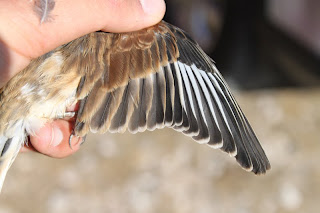After the Redwing movement on Monday we hoped there might be a rerun again today whereby we might catch a few of this special thrush together with other species on the move.
Overnight it was clear and starry, neither Will nor me heard any Redwings going over in the dark so when we arrived at Rawcliffe Moss to a white ground frost we weren’t too hopeful of catching many birds or seeing much visible movement at this inland location. Having said that, a raised track crosses the moss that allows a 360 degrees view and it is extremely quiet when listening for overhead birds.

I would describe migration this morning as a “steady trickle” of most species we saw which started at about 0800 then more or less stopped at 10am as the cloud cover increased to 100%. All counts south unless described as other:
Redwing, small parties of tens and teens, total 120
Fieldfare, 2
Jay, 2
Yellowhammer, 3
Linnet, 3
Woodpigeon, tight flock of 80 south west, plus 300/400 in near woods
Albas, 15
Goldfinch, 3
Blackbird, 9
Song Thrush, 3
Meadow Pipit, 20
Skylark, 18 plus 200 in stubble fields
Chaffinch, 40
Snipe, 6
Stonechat, 1
Pink-footed Goose, 150ish arriving from Pilling direction
Tawny Owl, 2 calling before dawn
Buzzard, 2 locals
Kestrel, 2 locals
Lapwing, 1000 further west on Pilling Moss
Pictures below of some of the birds ringed this morning, top to bottom: Redwing, adult female Fieldfare, juvenile Stonechat, and juvenile male Reed Bunting.




Overnight it was clear and starry, neither Will nor me heard any Redwings going over in the dark so when we arrived at Rawcliffe Moss to a white ground frost we weren’t too hopeful of catching many birds or seeing much visible movement at this inland location. Having said that, a raised track crosses the moss that allows a 360 degrees view and it is extremely quiet when listening for overhead birds.

I would describe migration this morning as a “steady trickle” of most species we saw which started at about 0800 then more or less stopped at 10am as the cloud cover increased to 100%. All counts south unless described as other:
Redwing, small parties of tens and teens, total 120
Fieldfare, 2
Jay, 2
Yellowhammer, 3
Linnet, 3
Woodpigeon, tight flock of 80 south west, plus 300/400 in near woods
Albas, 15
Goldfinch, 3
Blackbird, 9
Song Thrush, 3
Meadow Pipit, 20
Skylark, 18 plus 200 in stubble fields
Chaffinch, 40
Snipe, 6
Stonechat, 1
Pink-footed Goose, 150ish arriving from Pilling direction
Tawny Owl, 2 calling before dawn
Buzzard, 2 locals
Kestrel, 2 locals
Lapwing, 1000 further west on Pilling Moss
Pictures below of some of the birds ringed this morning, top to bottom: Redwing, adult female Fieldfare, juvenile Stonechat, and juvenile male Reed Bunting.























































.jpg)












